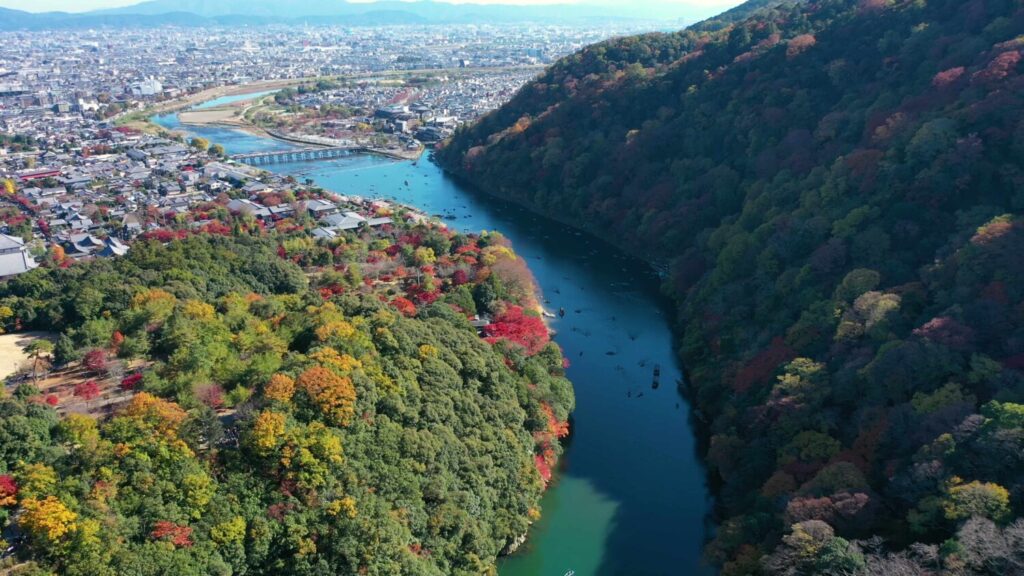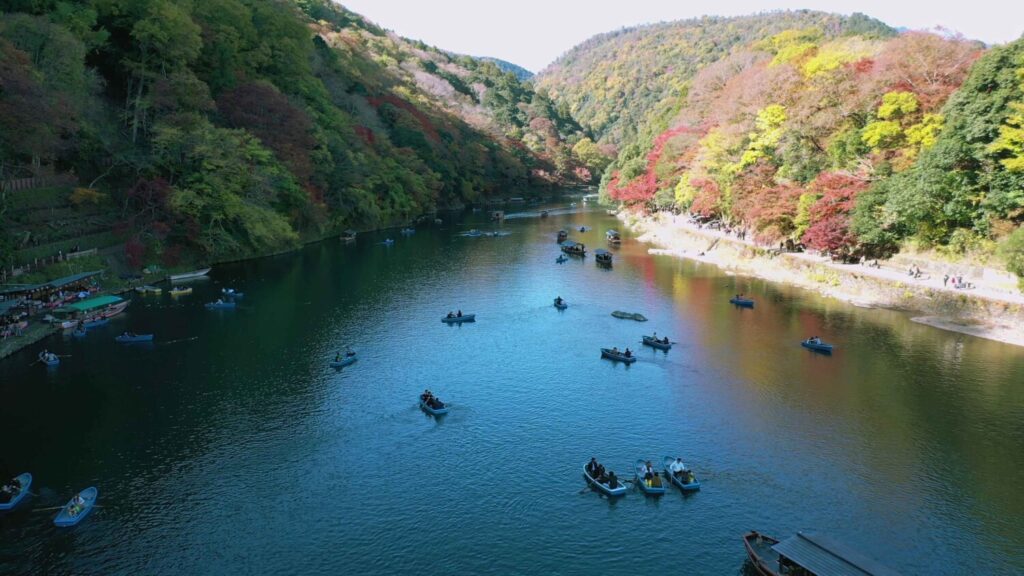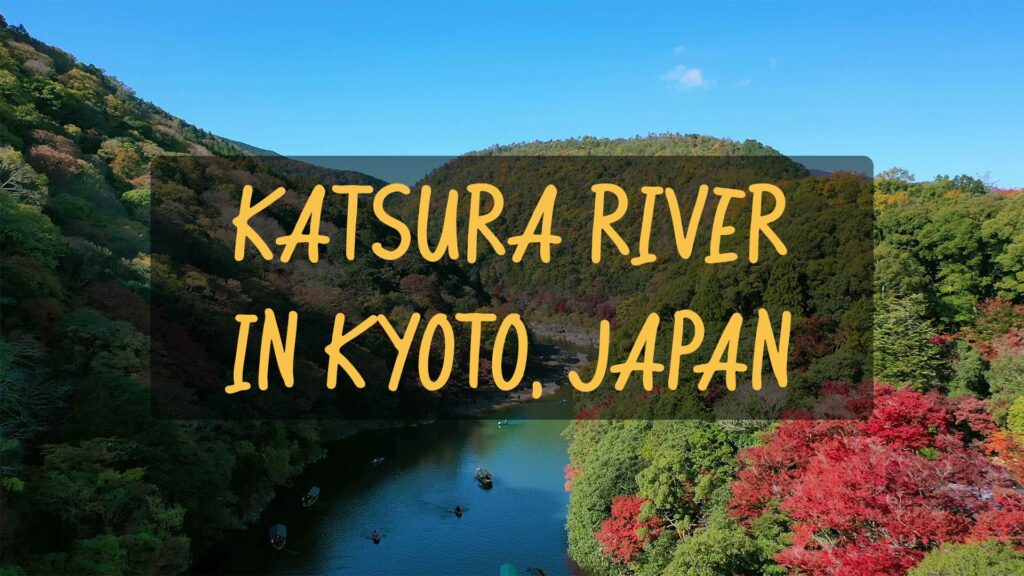The Katsura River, known as “Katsuragawa” in Japanese, flows through the western part of Kyoto, Japan, It is a river filled with natural beauty, historical significance, and cultural importance.
The river stretches approximately 107 kilometers from its source in the mountains of Shiga Prefecture to its mouth in Osaka Bay.
The Katsura River is a popular destination for tourists and locals alike, offering a serene escape from the hustle and bustle of city life.
A Natural Haven
The Katsura River is renowned for its stunning natural scenery, The riverbanks are lined with lush greenery, providing a tranquil environment perfect for leisurely strolls.
In spring, cherry blossoms bloom along the river, creating a picturesque landscape that attracts photographers and nature lovers.
During autumn, the leaves change color, painting the area in vibrant shades of red, orange, and yellow. This seasonal transformation makes the Katsura River a year-round attraction.
Historical and Cultural Significance
The Katsura River has played a vital role in Japanese history and culture, It has been a source of inspiration for poets, artists, and writers for centuries.
The river was also essential for transportation and trade during ancient times. Along its banks, you will find several historic sites, including the famous Katsura Imperial Villa.
This villa, built in the early Edo period, is a masterpiece of traditional Japanese architecture and garden design, Visitors can tour the villa and its gardens, gaining insight into the elegance and sophistication of Japanese culture.
Recreational Activities
The Katsura River offers a variety of recreational activities for visitors, Boating is a popular pastime, and you can rent a traditional wooden boat to paddle along the gentle waters.
Fishing enthusiasts can try their luck catching Ayu, a type of sweetfish found in the river. For those who prefer a more relaxed experience, picnicking by the riverbank is a delightful way to spend an afternoon.
The river’s calm atmosphere and beautiful surroundings make it an ideal spot for relaxation and reflection.
Modern Attractions

In addition to its natural beauty and historical sites, the Katsura River is close to several modern attractions, The Arashiyama district, located near the river, is a bustling area filled with shops, restaurants, and temples.
The iconic Togetsukyo Bridge spans the river in Arashiyama, offering a great vantage point for photos, Another notable attraction is the Bamboo Grove, where towering bamboo stalks create a magical, otherworldly ambiance.
These nearby attractions make a visit to the Katsura River even more enjoyable.
How to Spend Time in Kyoto
Spending time in Kyoto offers a rich blend of historical, cultural, and natural experiences. Start your visit by exploring the city’s famous temples and shrines, such as the iconic Kinkaku-ji (Golden Pavilion) and Fushimi Inari-taisha with its thousands of red torii gates.
Take a leisurely stroll through the Arashiyama Bamboo Grove and enjoy the serene ambiance. For a taste of traditional Kyoto, visit the Gion district, where you might catch a glimpse of geisha and enjoy a traditional tea ceremony. Don’t miss the beautiful gardens at places like Ryoan-ji and the Kyoto Imperial Palace.
For a culinary adventure, try Kyoto’s kaiseki cuisine, a multi-course meal that highlights seasonal ingredients. Lastly, exploring the Katsura River by boat or walking along its scenic banks offers a peaceful retreat from the city’s hustle and bustle.
Why is Katsura River So Famous?
The Katsura River is renowned for its scenic beauty and historical significance. It flows through the picturesque Arashiyama area, which is a major attraction in Kyoto.
The river is famous for its stunning views, especially during the cherry blossom season in spring and the vibrant foliage in autumn. Historically, the river has been celebrated in Japanese literature and art, symbolizing natural beauty and tranquility.
Boat rides on the river offer a unique perspective of Kyoto’s landscape, passing under traditional wooden bridges and alongside lush greenery. The river’s serene environment has made it a popular spot for both locals and tourists seeking relaxation and a connection to nature.
How Many Days Do You Need in Kyoto?
To fully appreciate Kyoto’s rich cultural and historical offerings, it is recommended to spend at least three to four days in the city. This duration allows you to explore the main attractions without rushing.
You can dedicate one day to the eastern part of the city, visiting places like Kiyomizu-dera, Gion, and Higashiyama District. Another day can be spent in Arashiyama, enjoying the bamboo grove, the Katsura River, and nearby temples.
Reserve a day for the northern areas, including the Golden Pavilion (Kinkaku-ji) and Ryoan-ji. Use the remaining time to explore the central areas, including Nijo Castle and Nishiki Market. This itinerary provides a balanced experience of Kyoto’s temples, gardens, cultural activities, and local cuisine.
Why is the Katsura River the Most Liveable River?
The Katsura River is often considered highly liveable due to its clean waters, beautiful surroundings, and the sense of peace it offers. The river is well-maintained and free from pollution, making it an ideal spot for recreational activities such as boating, fishing, and riverside picnics.
The surrounding area is lush with greenery, providing a habitat for diverse wildlife and contributing to a healthy ecosystem. The river’s banks are lined with walking and cycling paths, promoting an active lifestyle. Additionally, the presence of historical and cultural sites along the river enhances its appeal as a place where nature and heritage coexist harmoniously.
Why Must You Visit the Katsura River?
Visiting the Katsura River is a must for experiencing Kyoto’s natural beauty and tranquility. The river is a perfect escape from the city’s hustle, offering peaceful boat rides and scenic walks along its banks.
The Katsura River area is especially beautiful during the cherry blossom season in spring and the autumn foliage, providing breathtaking views. Additionally, the river is located near popular attractions like the Arashiyama Bamboo Grove and Tenryu-ji Temple, making it a convenient and worthwhile stop.
The river’s serene ambiance, coupled with its historical and cultural significance, provides a unique and memorable experience for any visitor.
Where is Katsura River Located?
The Katsura River is located in the western part of Kyoto, Japan. It flows through the scenic Arashiyama district, which is a major tourist destination known for its natural beauty and cultural heritage.
The river originates from the Tamba Mountains and runs through Kyoto Prefecture, eventually merging with the Kizu River. The Katsura River is easily accessible from central Kyoto by train or bus, making it a popular spot for day trips.
The area around the river, especially in Arashiyama, is filled with attractions such as the bamboo grove, traditional temples, and picturesque landscapes, all contributing to its charm.
What is the Best Month to Visit the Katsura River?

The best time to visit the Katsura River is during the spring months of March to April or the autumn months of October to November. In spring, the area is adorned with cherry blossoms, creating a stunning pink landscape that attracts numerous visitors.
Autumn offers a different but equally beautiful experience, with the foliage turning vibrant shades of red, orange, and yellow. These periods offer mild and pleasant weather, ideal for outdoor activities such as boat rides, walking, and photography.
Visiting during these peak seasons ensures you experience the Katsura River at its most picturesque and enjoyable.
What Can I Do in Kyoto?
Kyoto offers a diverse range of activities for visitors. Explore its numerous temples and shrines, such as Fushimi Inari-taisha, Kinkaku-ji, and Kiyomizu-dera, each offering unique architectural beauty and historical significance.
Stroll through the Arashiyama Bamboo Grove and visit the nearby Monkey Park for a mix of nature and wildlife. Enjoy traditional Japanese tea ceremonies in teahouses or ryokan (traditional inns). Explore the Gion district to experience Kyoto’s geisha culture and enjoy a kaiseki meal, which is a multi-course traditional Japanese dinner.
Don’t miss the Philosopher’s Path, especially during cherry blossom season, and the vibrant Nishiki Market for local food and crafts. Kyoto also offers various festivals throughout the year, providing a glimpse into local traditions and celebrations.
Is Katsura River Worth Visiting?
Yes, the Katsura River is definitely worth visiting. It offers a serene and picturesque escape from the city, surrounded by lush landscapes and historical sites. Whether you’re taking a boat ride, walking along its scenic banks, or simply enjoying the peaceful ambiance, the river provides a unique and memorable experience.
The Katsura River is particularly beautiful during the cherry blossom season in spring and the autumn foliage, offering breathtaking views. Its proximity to other major attractions in the Arashiyama district, such as the bamboo grove and Tenryu-ji Temple, makes it a convenient and worthwhile addition to any Kyoto itinerary.
Conclusion
Kyoto, with its blend of cultural heritage, historical significance, and natural beauty, is a city that offers an unforgettable experience. The Katsura River stands out as a highlight, providing serene landscapes, recreational activities, and a connection to Kyoto’s rich history.
Whether you are exploring ancient temples, enjoying seasonal beauty, or immersing yourself in traditional Japanese culture, Kyoto and the Katsura River have something unique to offer every visitor. With thoughtful planning, you can make the most of your time in this enchanting city, creating memories that will last a lifetime.

